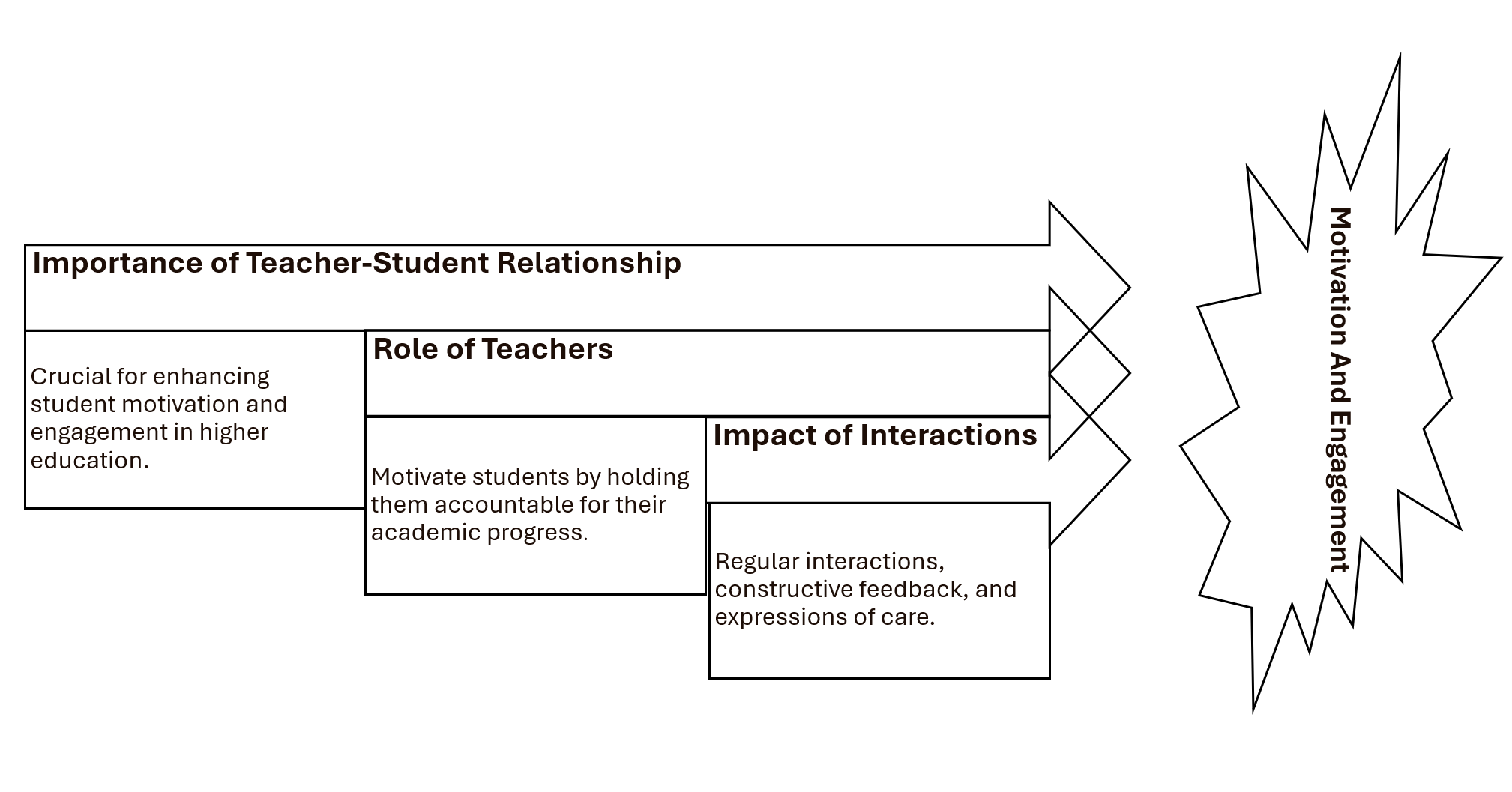What is Teacher-Student Relationship (TSR)?
Teacher-Student Relationship (TSR) refers to the dynamic bond between teachers and students, shaped by thoughts, feelings, and actions in the classroom. The nature of TSR involves ‘a state of connectedness between people, especially an emotional connection’.
(Jowett et al., 2023; Forsen 2016)
Why is TSR important?
TSR model highlights how positive connections between educators and students are crucial for Enhancing Motivation and Engagement in higher education.
Teachers play a key role by fostering accountability and providing supportive interactions. Regular feedback and expressions of care further strengthen the relationships, ultimately boosting student motivation and engagement.

(Wang et. al., 2025)
TSR in Situated Expectancy-Value Theory (SEVT)
TSR plays a crucial role within the Situated Expectancy-Value Theory (SEVT) framework. Situated under the influence of the 3Cs —Commitment, Closeness, and Complementarity—TSR significantly affects students’ competence beliefs, success expectations, and task values.
The 3Cs model was developed to examine the Coach–Athlete relationship quality and is grounded in interdependence theory. It proposes that relationships are defined through inter-personal interdependence which is “the process by which interacting people influence one another’s experience”.
Expanded Definition of the 3Cs
- Commitment: Commitment from both the teacher and student is vital for a successful advising relationship. It means dedicating time and effort to the process.

- Closeness: Closeness refers to the level of trust and rapport established between the teacher and student.

- Complementarity: Complementarity signifies how well the teaching and learning styles align. When teachers understand students’ needs and cater for those needs, the advice is more effective.

These factors, in turn, influence students’ academic engagement on emotional, cognitive, and behavioral levels. A positive TSR fosters stronger expectations and values, ultimately leading to deeper learning engagement over time.
(Jowett et al., 2023; Eccles & Wigfield, 2024; Reeve, 2013: Van Lange & Balliet, 2015)

To learn more, please refer to our TSR Micro-module 2: Understanding Teacher Student Relationship through the SEVT Model
Definitions of each SEVT elements:
- Commitment: Dedicating time and effort to the process.
- Closeness: Level of trust and rapport established between the teacher and student.
- Complementarity: How well the teaching and learning styles align.
- Expectancy: A student’s belief that they can succeed in their academic pursuits.
- Intrinsic Value: Inherent satisfaction and enjoyment derived from the learning process itself.
- Important Value: The belief in the value or importance of achieving an academic goal.
- Costs: relative costs, e.g. time and effort, associated with academic activities.
- Emotional: student’s feelings and attitudes towards learning.
- Cognitive: student’s investment in learning, such as critical thinking and problem-solving.
- Behavioral: student’s active participation in academic activities and tasks.
The 3Cs:
Motivational Factors:
Active Engagement:
A supportive environment, along with high confidence (expectancy) and meaningful goals (value), leads to greater student engagement. However, emotional costs like burnout can hinder motivation, and supportive teachers play a key role in addressing this challenge.
(Reeve, 2013; Monteiro et al., 2021)
|
Affiliation / Warmth |
Assertion / Status |
Attachment / Safety |
|
|
|
(Quinlan, 2016)
To learn more, please refer to our TSR Micro-module 3: Practical Strategies for Enhancing Teacher-Student Relationship and Establishing A Learning Community
Benefits of Positive TSR to Students
- Emotional Support: Positive teacher-student relationships provide students with emotional reassurance, fostering a sense of safety and belonging.
- Increased Engagement: Students are more likely to participate actively in class discussions and activities when they feel connected to their teachers.
- Enhanced Motivation: Positive relationships with teachers boost students’ intrinsic motivation to learn and explore new ideas.
- Individualized Attention: Teachers can better understand each student’s unique needs and tailor their support accordingly.
Benefits of Positive TSR to Teachers
- Enhanced Teaching Practices: Positive TSR supports engaging content delivery, problem-solving, critical thinking, and effective instruction monitoring.
- Personal Accomplishment: Closeness with students boosts teachers’ sense of achievement.
- Reduced Burnout: Lower conflict with students decreases emotional exhaustion.
(Li et al., 2022; Corbin et al., 2019)
Conclusion
TSR also influences Student-Student Relationships (SSR), contributing to a vibrant learning community. Teachers create a welcoming environment through warmth and encouragement, which helps students feel connected. Supportive actions, such as praising effort and encouraging peer interactions, play a crucial role. When teachers demonstrate enthusiasm, students tend to reflect that, strengthening their connections with classmates. A positive SSR promotes engagement and lowers stress, aligning with SEVT’s social factors affecting motivation.
- Corbin, C. M., Alamos, P., Lowenstein, A. E., Downer, J. T., & Brown, J. L. (2019). The role of teacher-student relationships in predicting teachers’ personal accomplishment and emotional exhaustion. Journal of School Psychology, 77, 1–12.
- Eccles, J. S., & Wigfield, A. (2024). The development, testing, and refinement of eccles, wigfield, and colleagues’ situated expectancy-value model of achievement performance and choice. Educational Psychology Review, 36(2), Article 51. https://doi.org/10.1007/s10648-024-09888-9
- Forsen, D. M. (2016). Developing good teacher-student relationships A multiple-case study of six teachers’ relational strategies and perceptions of closeness to students [Doctoral dissertation]. https://discovery.ucl.ac.uk/id/eprint/1474062/1/Fosen_EdD%20Thesis%20Dagny%20%20final.pdf
- Jowett, S., Warburton, V. E., Beaumont, L. C., & Felton, L. (2023). Teacher-Student relationship quality as a barometer of teaching and learning effectiveness: Conceptualization and measurement. British Journal of Educational Psychology, 93(3), 842–861. https://doi.org/10.1111/bjep.12600
- Li, B., Bergen, J., & Olsen, A. (2022). Teacher-student relationships and teaching practices. Journal of Educational Research.
- Monteiro, V., Carvalho, C. & Santos, N. N. (2021). Creating a Supportive Classroom Environment Through Effective Feedback: Effects on Students’ School Identification and Behavioral Engagement. Frontiers in Education. (Vol. 6, p. 661736). https://doi.org/10.3389/feduc.2021.661736
- Quinlan, K. M. (2016). How Emotion Matters in Four Key Relationships in Teaching and Learning in Higher Education. College Teaching, 64(3), 101–111. https://doi.org/10.1080/87567555.2015.1088818
- Reeve, J. (2013). How students create motivationally supportive learning environments for themselves: The concept of agentic engagement. Journal of Educational Psychology, 105(3), 579–595. https://doi.org/10.1037/a0032690
- Van Lange, P. A. M., & Balliet, D. (2015). Interdependence theory. In M. Mikulincer, P. R. Shaver, J. A. Simpson, & J. F. Dovidio (Eds.), APA handbook of personality and social psychology, Vol. 3. Interpersonal relations (pp. 65–92). American Psychological Association. https://doi.org/10.1037/14344-003
- Wang, Y., Lee, W. Y., King, R., & Lee, L. F. (2025). Positive teacher-student relationship promotes students’ engagement in higher education: A mediation role of motivational beliefs. Internal document, Centre for Learning Enhancement and Research.
